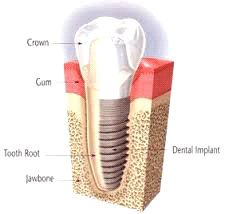→ GENERAL DENTISTRY
→ PEDIATRIC DENTISTRY
→ IMPLANT DENTISTRY
→ ORAL SURGERY
 Implant Dentistry
Implant Dentistry
Dental implants can be an excellent option to replace single or multiple teeth. Dr. Patrick received extensive training during his residency in both placing and restoring dental implants. Implants can be placed at the time of extraction or after the extraction site has healed. After completing hundreds of implant cases from start to finish Dr. Patrick can achieve optimal esthetic results for his patients. Dr. Patrick is fully qualified to perform sedation dentistry and administer nitrous oxide, both of which may be required for complex procedures.
What is a dental implant?
A Dental Implant is an artificial tooth ROOT. It is the portion of an artificial tooth that fits into the gum and bone of the jaw, and it is made of the metal titanium. This same metal is used throughout the body with other implantable devices such as artificial joints. Titanium metal is strong, lightweight, corrosion resistant, and modifiable into various shapes.
A dental implant has threads on the outside so that it attaches quickly to the bone of the jaw to provide initial stability when placed by the surgeon. The interior of the dental implant is tapped with machine threads to allow various devices to screw into the top part of the implant. These devices on top of the implant can then be used to retain individual caps, bridgework, or removable dentures.
The final stability of any dental implant comes through a microscopic growth of bone into the surface coating of the implant. The surface preparation has microscopic tunnels, nooks, crannies, and undercuts. Once placed in the jaw, and over a period of several months, the patient’s bone actually grows into the surface of the implant and mechanically locks the device into the jaw.
The dental implant tooth is actually 3 pieces precisely fitted and stacked one upon the other. The bottom is the titanium metal implant, the middle that is screwed into the implant is the Prosthetic Abutment, and the top portion that everyone sees is the white Porcelain Dental Crown.
A dental implant can be used in various configurations depending upon the patient’s needs. It can be support an individual crown or cap, a bridge of multiple caps, or it can be used to supply retention to a removable denture.
Once teeth are lost from the jaw, the bone resorbs or melts away with time. The presence of a tooth root or dental implant will stop this melting process.
What is bone and gum grafting?
The Dr. Patrick may decide that implants simply must be placed in a position where there is an inadequate amount of bone or soft tissue (gum). In this instance, grafting is undertaken either as an individual first surgery before the implant is placed, or the grafting may be done with the placement of the implants.
Bone grafts are commonly employed when a multi-rooted tooth is removed and the area is to be restored with a single, wide-body implant. Taking out the multi-rooted tooth results in a larger defect in the bone, and inadequate bone coverage of the implant results. Another common area of grafting is the underside of the sinus cavity in the upper jaw. Lifting the sinus membrane and inserting a layer of bone graft allows much longer implants to be placed here.
Traumatic loss of teeth or teeth that have been removed many years ago frequently results in an inadequate layer of gum tissue at the implant site. In this instance, soft tissue grafting is employed before, during, or after the placement of the implant.
What should I expect during my implant surgery?
Patients undergoing implant surgery while always receive local anesthesia (numbing), but may choose to supplement this with nitrous oxide or undergo oral conscious sedation. The gum tissue is opened to reveal the underlying bone. The surgical guide is inserted, and the location is prepared with precision tools and instruments to receive the planned implant of specific diameter and length.
The outside threads on the implant give the implant an initial stability referred to as “seating torque.” The gum tissue is then sutured over the top of the implant so that it rests back into its original position. The implant is buried completely under the gum tissue and left for about 4 months.
During the ensuing waiting period, the bone grows microscopically into the surface coating of the titanium metal implant. The implant must be kept very still during this process, and it is kept from chewing or “loading.” It is quite similar to cement setting, but it is a biologic process.
What happens after my implant is placed (second stage)?
Most of the time, Dr. Patrick is able to place a healing abutment or temporary tooth on top of the implant at the time of surgery. Sometimes, there may be a second surgical appointment. This usually occurs after a 4 to 6 month waiting period. At this time, the gum tissue is reentered using local anesthesia. The Healing Screw that is a small, flat screw in the top of the implant is removed. A Healing Abutment is placed in the machine-tapped inner channel of the implant. The Healing Abutment is a metal dome that pokes through the gums. Its purpose is to shape the gum tissue to form a dish shaped “nest” that will reside against the underside of the planned dental crown. This nest is necessary to make the dental cap look natural and to cover the junction of the implant and cap.
What happens when I am ready for my restoration?
The round Healing Abutment is left in place for about two weeks and can be removed and replaced by the family dentist without any numbing medicine. There is no sensation when it is unscrewed and replaced with a Prosthetic Abutment that is cone shaped. The family dentist will take an impression of the abutment and consult with the Laboratory Technician in regard to shape, size, and color of the desired crown or cap. This is the final metal piece to which the white dental crown or cap is cemented.
Reliability and Maintenance
There are many scientific studies that show that dental implants have greater than a 95% success rate over a 5 year period. However, dental implants can fail just like natural teeth fail. If a person loses natural teeth because of a specific process, then it follows that implant supported teeth can be lost from the same process. And by the same token, if dental implants are cared for with the same devoted attention as natural teeth, then they should last a lifetime.
Natural teeth and implant-supported teeth are generally lost from a few common causes:
- Poor Oral Hygiene
- Destructive Grinding of the Teeth
- Tobacco Use
Dental implants must be kept clean the same way that natural teeth are cleaned, and oral hygiene should be periodically evaluated by dental professionals. Gum disease from poor oral hygiene causes the melting away of supportive bone to the teeth and implants. They will become loose and literally fall out if not kept clean.
One unique circumstance of the titanium metal implants is that they do not decay the way that dental enamel does. Certain medications prescribed for medical diseases can cause the salivary glands to quit producing fluid and this results in dry mouth (Xerostomia). This dry mouth can be terribly destructive to natural teeth. Decay can develop between the teeth, around fillings, and under caps even though the patient works diligently to keep the teeth clean. Metal implants are not subject to this decay and find frequent use in patients suffering from dry mouth.
Unconscious clenching and grinding of the teeth (Bruxism) can cause natural teeth to wear excessively, fracture, and literally split between the roots. Even in milder cases of Bruxism, the accumulation of destruction over a long period time can take its toll. Consequently, fractured teeth are frequently seen in the maturing population. If the Bruxism is especially strong, the same deleterious action can take place on the dental implant, and it can be lost.
Tobacco causes so many harmful effects on the body, and the teeth suffer also. Bone loss (Periodontitis) even in clean teeth can occur, and the same process affects implants. In fact, it is generally understood that a 10% increase in the failure rate of implants occurs with tobacco use.
When a dental implant does fail, it usually can be replaced. Some implants fail for no apparent reason in the early months after initial placement. In these situations, the implant can be removed, a two-month waiting period is allowed for healing, and a new, same-sized implant placed in the same location.
Implant Restorations
What are single implant crowns?
While there is some variation in procedure, the following outlines the basic steps required for dental implant placement. The first portion of the procedure is implant placement. The gum covering the area is gently folded back and the underlying bone prepared to receive the implant. The extent of the bone preparation is dependent on the number of implants required. The implant(s) are then placed, and the gum sutured. The implant should fully integrate into the bone after 3 to 6 months. At this point, a custom-designed crown is fitted over the post. The details of the procedure change slightly with the structure of the implant used.
What are implant supported bridges?
An implant-supported bridge is similar to a regular dental bridge, but it is supported by implants and not by natural teeth. In most cases, when an implant-supported bridge is used, one implant is placed in the jawbone for each missing tooth. Then the crowns are connected to each other to form one piece.
What are overdentures?
Overdentures were developed to help both partial and fully edentulous patients regain a quality of life. There are three types of overdentures:
- Implant-retained, Gum Supported
- Bar-retained, Implant Supported
- Fixed, Implant Supported
What are implant retained, gum supported overdentures?
With this treatment, the overdenture rests directly on your gums and is retained by implants placed into your upper and/or lower jaw. The overdenture, which is removable, is secured to your implants through retentive attachments incorporated into the denture. Implant-retained tissue supported dentures are currently recognized as the minimum standard of care for fully edentulous patients.
What are bar-retained, implant supported overdentures?
With this treatment, the overdenture engages retentive attachments on a metal bar that connects to implants, which are placed into your upper and/or lower jaw. The overdenture, which is removable, is secured to the bar through attachments fabricated directly into the denture.
What are fixed, implant supported overdentures?
With this treatment, the overdenture and bar are a one-piece framework secured using screws to implants placed into your upper and/or lower jaw. The overdenture is only removable by a dentist and is the most like natural teeth due to not having flanges and not resting on the gums.
Call Daniel Family Dentistry today for a consultation to learn more about the different types of implant restorations.

